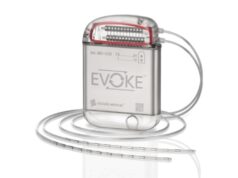 SafeOp Surgical has filed its tenth patent application for innovations surrounding the monitoring and real-time detection of motor nerve thresholds during surgery. SafeOp developed and markets the EPAD system, a neuromonitoring platform that enables the detection of nerve damage and post-operative residual paralysis during surgical procedures.
SafeOp Surgical has filed its tenth patent application for innovations surrounding the monitoring and real-time detection of motor nerve thresholds during surgery. SafeOp developed and markets the EPAD system, a neuromonitoring platform that enables the detection of nerve damage and post-operative residual paralysis during surgical procedures.
This latest filing is for the added capability to stimulate nerves during surgery to rapidly detect responses that help the surgical team identify the proximity and health of nearby nerves. SafeOp already holds or has provisional patents for detection of peripheral nerve injury using somatosensory evoked potentials, as well as signal processing and high specificity in alerting to signal change, and on neuromuscular junction testing and spinal cord stimulator paddle placement in one or more of the United States, European Union, Australia, Japan and China.
“Detecting the proximity of nerves, including whether surgical instruments may have breached bones that are close to nerves, is essential in avoiding inadvertent nerve injury during surgery. Injuries such as those to the femoral nerve, which controls the ability to extend a leg, can be devastating,” says Richard O’Brien, SafeOp’s vice president of development and chief medical officer. “While other techniques exist for detecting nerve proximity during some surgeries, this new capability has the advantage of partially accounting for the presence of paralytic agents that can interfere with testing while still maintaining speed. This makes the likelihood of false negative responses less likely.”
SafeOp’s EPAD system platform currently allows monitoring of both the spinal cord and peripheral nerves. It was developed specifically for the rapid detection of perioperative nerve injury. Perioperative nerve injury is a frequent complication of some surgeries (such as orthopaedic, general, cardiac, or urological), whereby peripheral nerves may be damaged due to unrecognised extended compression or stretching, or compromise of their blood supply. The EPAD system also allows easy-to-use quantitative monitoring of the neuromuscular junction to help detect another frequent complication, post-operative residual paralysis. This may occur when paralysing agents have not sufficiently worn off at the end of surgery. The EPAD system provides real-time feedback, allowing caregivers to adjust the patient’s position or surgical technique in time to avoid nerve injury, or to intervene when residual paralysis is present.
“This latest patent filing is another example of the powerful capabilities of the EPAD system platform. We expect this new capability to allow utilisation of the EPAD in surgeries such as the lateral approach, a type of spine surgery, and other standard spine surgeries that can benefit from motor nerve mapping technology,” said Gene Cattarina, SafeOp’s president and chief executive officer. “In addition to this patent filing, we anticipate releasing EPAD’s electromyography (EMG) capability in the first quarter of 2018.”












